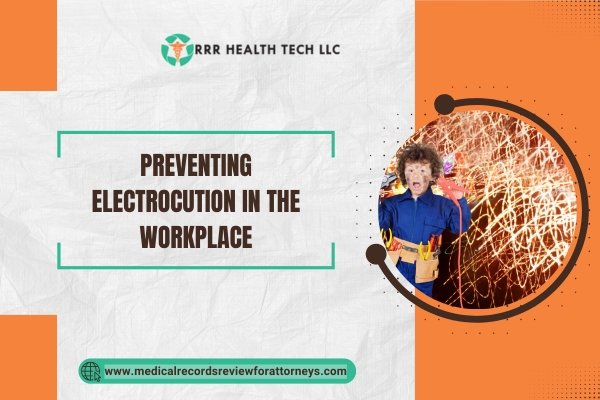
Electrocution is a workplace risk that ranks high in injuries and fatalities. A safe working environment can be maintained understanding the principles on how to avoid electrocution. This article explains a comprehensive overview of the causes of electrocution, how to prevent it, and what to cross examine in medical records in a legal case of workplace injury.
Understanding Electrocution
It involves the serious harming or death of a person through voltage either by electric shock or in connection with a circuit. Most typically, electrocution occurs in industries like electrical works, construction, and maintenance work. Aspects to consider include:
• Definition: The term commonly used to refer to death or serious injury resulting from an electric shock.
• Statistics: Based on findings from the U.S. Bureau of Labor Statistics, electrocution is approximately responsible for 8% of workplace deaths.
Understanding the nature of electrocution is crucial for implementing effective safety measures.
Common Causes of Electrocution in the Workplace
Identifying the common causes of it can help in developing preventive strategies. Some of the most frequent causes include:
- Faulty Equipment: Electrical devices that are not working correctly can become a danger.
- Misuse of Extension Cords: Overloading cords or using cords that are damaged is certainly hazardous.
- Lack of Grounding: Equipment that is not properly grounded increases the risk of electric shock.
- Wet Conditions: Working in wet environments without proper precautions can lead to electrocution.
By recognizing these risks, employers can take proactive steps to mitigate them.
Legal Implications of Electrocution Cases
When it occurs in the workplace, there can be significant legal implications, including:
- Claims for Worker’s Compensation: The employee affected from sustained injuries may be compensated for their worker’s claim.
- Lawsuits for Negligence: An employee who gets injured due to an unsafe working environment gets the chance to sue for negligence.
• Regulatory Penalties: OSHA has regulations set into places and failure to abide by them leads to legal problems.
Understanding these legal aspects is essential for both employers and employees.
Preventive Measures to Avoid Electrocution
Implementing effective preventive measures is crucial for reducing the risk of electrocution. Here are some strategies:
Scheduled Check of Tools
Follow up regularly to check if the electrical device or equipment functions properly to eliminate any chance of malfunction.
Multinational Team Support
All tools have to come with proper instructions that provide insight on safety measures.
Increasing Employee Safety
All, employees, especially those working with electric machines should have proper footwear, insulated gloves, or any other type of suited PPE.
Establish Lockout/Tagout Procedures
• Set procedures to ensure that machines can be turned off completely and cannot be started until after the maintenance or repair work is done.
Keep Work Environments Dry
• Make sure all work spaces are kept dry and free from moisture to reduce the risk of electric shock.
Place Ground Fault Circuit Interrupters (GFCIs)
• GFCIs should be placed where there is a possibility of water and electricity coming together, for example, in bathrooms and kitchens.
By adopting these measures, employers can significantly reduce the risk of electrocution in the workplace.
The Role of Medical Records Review in Electrocution Cases
Medical records review is a critical service that can assist attorneys in cases involving workplace electrocution. This process involves:
- Thorough Examination of Medical Records: Reviewing patient records to identify the extent of injuries and treatment received.
- Expert Testimony: Providing expert opinions on the standard of care and whether it was met in the case of the injured employee.
- Building a Strong Case: Assisting attorneys in gathering evidence to support claims of negligence or unsafe working conditions.
By leveraging medical records review, attorneys can enhance their case’s credibility and effectiveness.
Case Studies
Case Study 1:
Overview: A construction worker suffered severe injuries due to electrocution whilst using a defective power tool.
Challenges: The worker endured high medical costs and lost income due to the inability to work during the recovery period.
Solutions: The worker was provided legal assistance, and in the examination of medical records, the employer’s equipment maintenance deficiency was noted which proved to be a violation of medical safety laws.
Case Study 2:
Overview: An electrician sustained injuries while maintaining a powered switchboard because of his contact with a live ungrounded wire.
Challenges: The electrician had to bear prolonged health complications and trying to prove the employer’s culpability was also difficult.
Solutions: After reviewing medical records, it was clear that the employee was not sufficiently trained or provided with safety equipment which resulted in this incident.
Conclusion
Employers and employees have a crucial responsibility in ensuring that there is no workplace electrocution. From identifying the causes, to putting preventive measures in place, to understanding the legal ramifications of electrocution allows for these occurrences to be avoided. Additionally, the use of medical records review offers unparalleled assistance in legal matters concerning electrocution by aiding in ensuring that victims receive the appropriate justice and compensation for their suffering.


